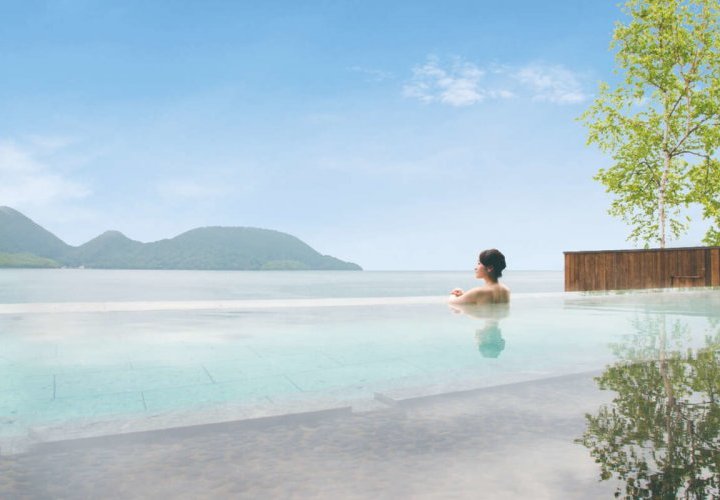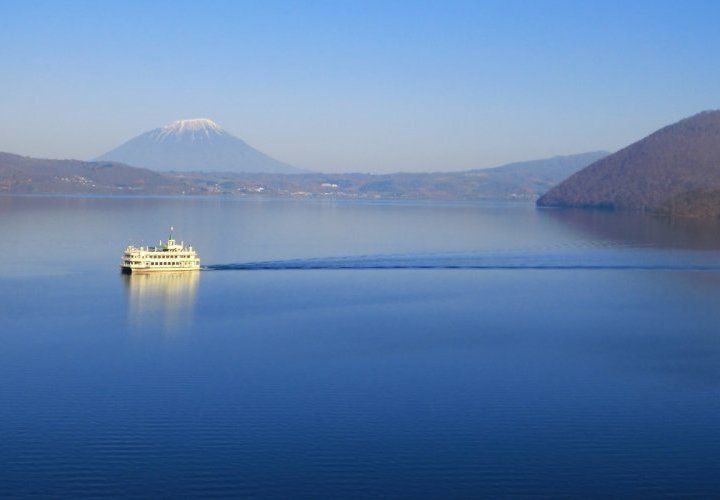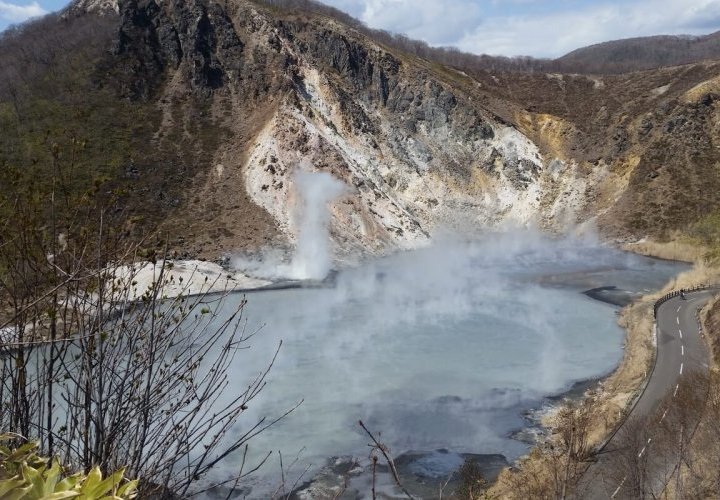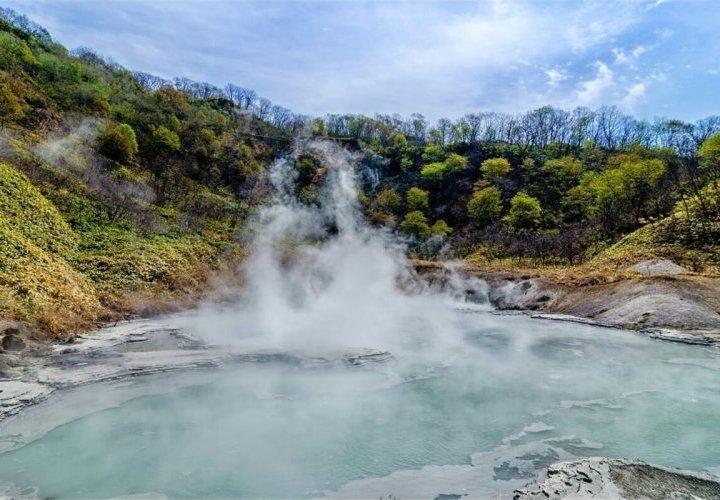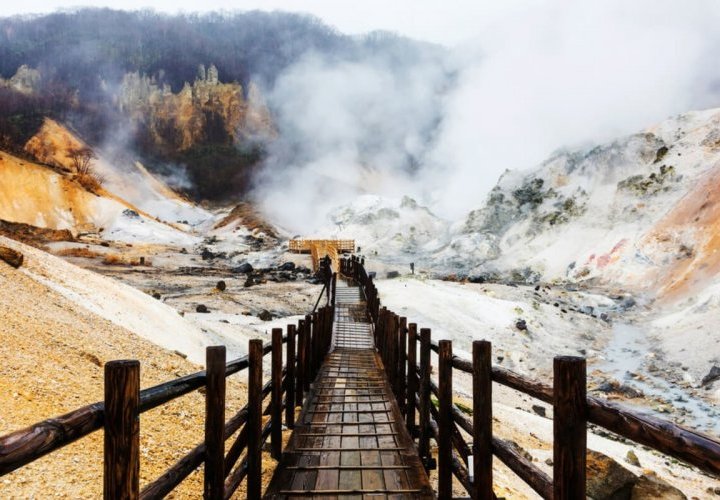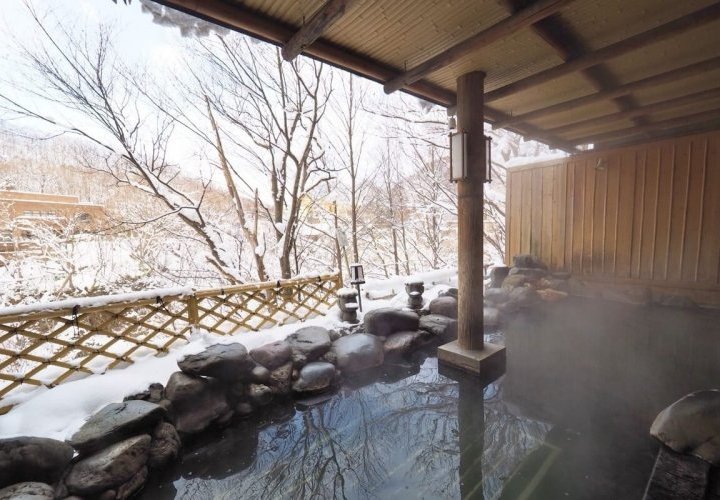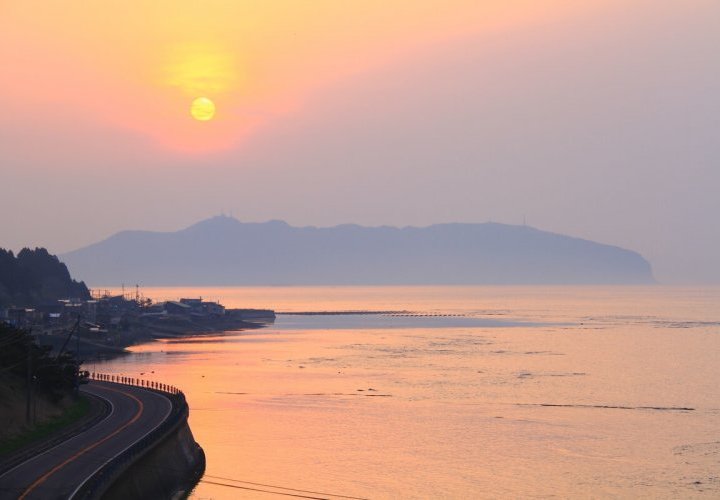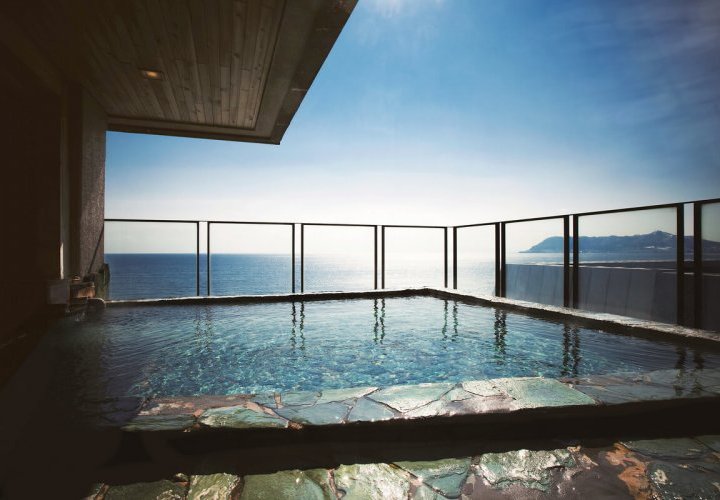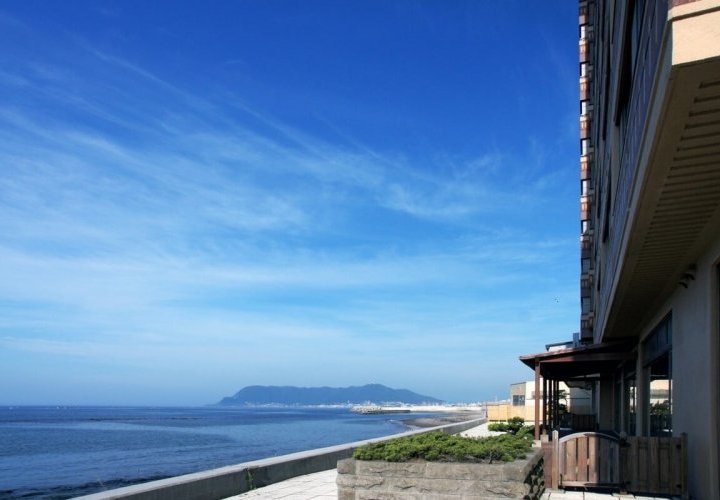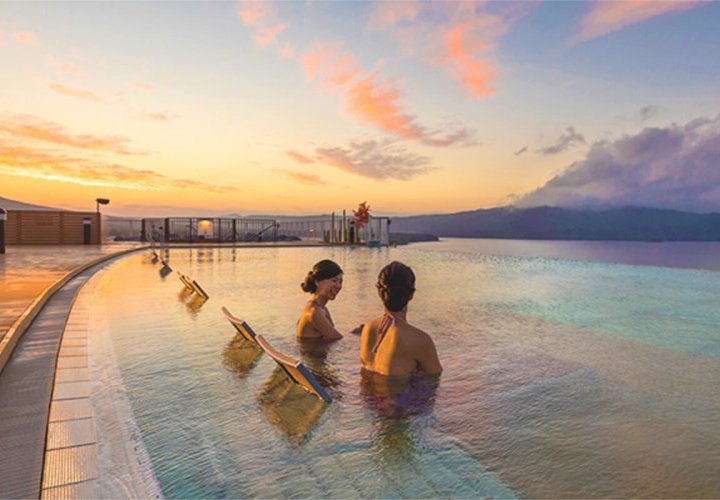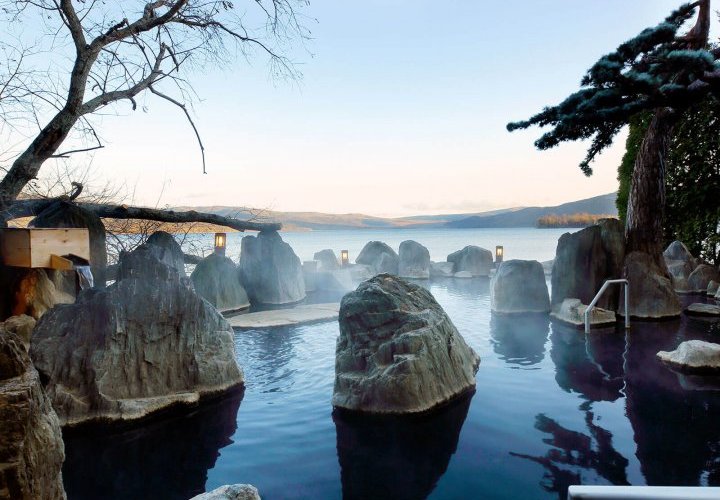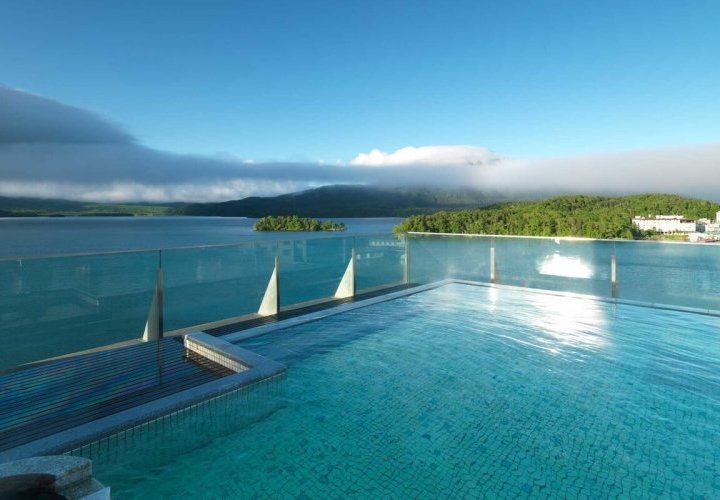With two major volcanic belts, Hokkaido has more than 240 hot springs. The colours, the way it feels and the benefits of the hot spring water vary depending on the locations. Most hot springs are blessed with beautiful surrounding landscapes that include lakes, gorges or other natural wonders.
Lake Toya Onsen or “Toyako Onsen” is one of the most popular onsen towns in Hokkaido offering nature landscapes, astonishing views and a nice variety of activities for you to enjoy during your stay. Located near Lake Toya, it provides you with the spectacular scenery of the lake as you soak in the hot springs making sure you will never get tired of this beautiful sight. Lake Toya is located in the northwestern part of Muroran city between Toyako town and Sobetsu town. It is the third largest caldera lake in Japan after Lake Kussharo and Lake Shikotsu, more
Lake Toya Onsen or “Toyako Onsen” is one of the most popular onsen towns in Hokkaido offering nature landscapes, astonishing views and a nice variety of activities for you to enjoy during your stay. Located near Lake Toya, it provides you with the spectacular scenery of the lake as you soak in the hot springs making sure you will never get tired of this beautiful sight. Lake Toya is located in the northwestern part of Muroran city between Toyako town and Sobetsu town. It is the third largest caldera lake in Japan after Lake Kussharo and Lake Shikotsu, more
and was formed by large-scale eruptions 110,000 years ago.
Most of the hotels and ryokan are located in an elevated area and the open-air hot spring baths are built in a way that makes it possible to enjoy the beautiful view of the lake. Lake Toya Hot Spring is also famous for its unique lakeshore fireworks held every night from late April to October and attracts around 4 million tourists every year.
The hot spring water from Lake Toya Onsen contains sodium, calcium, bicarbonate and sulphate and is said to be good for curing nerve and joint pains and for fatigue recovery. Besides the hot spring baths, you can take a cruise around the lake, walk around the lake and see the sculptures that are placed around it and take a rest at the cafés and shops after walking. You can also enjoy several “Ashiyu” or footbaths or get on the ropeway and enjoy the view from the top of Mount Usu.
Most of the hotels and ryokan are located in an elevated area and the open-air hot spring baths are built in a way that makes it possible to enjoy the beautiful view of the lake. Lake Toya Hot Spring is also famous for its unique lakeshore fireworks held every night from late April to October and attracts around 4 million tourists every year.
The hot spring water from Lake Toya Onsen contains sodium, calcium, bicarbonate and sulphate and is said to be good for curing nerve and joint pains and for fatigue recovery. Besides the hot spring baths, you can take a cruise around the lake, walk around the lake and see the sculptures that are placed around it and take a rest at the cafés and shops after walking. You can also enjoy several “Ashiyu” or footbaths or get on the ropeway and enjoy the view from the top of Mount Usu.
Noboribetsu is one of the most famous hot spring resorts in Hokkaido, being visited by about 3 million tourists every year. This hot spring town is located 200 m above sea level and is famous all over Japan for its abundant, high quality water of different kinds of hot springs with different healing properties. Noboribetsu Hot Spring is featured by a daily output of as much as 10,000 litres of hot spring water. It is said that the foundation of the hot spring resort was formed when Mr. Kinzo Takimoto opened a hot-spring inn on this land in 1858.
The resort town consists of many (mostly large sized) ryokan and hotels with hot spring baths. Some of them open their baths during daytime to non-staying guests. There is one public bathhouse located in the centre of town named Sagiriyu. Even if all its baths are indoor, more
The resort town consists of many (mostly large sized) ryokan and hotels with hot spring baths. Some of them open their baths during daytime to non-staying guests. There is one public bathhouse located in the centre of town named Sagiriyu. Even if all its baths are indoor, more
they are bright and attractive and seem to be popular among the locals. The baths feature two types of water in three pools and a sauna.
Jozankei is a famous hot-spring resort in Sapporo city suburb surrounded by beautiful greenery and magnificent canyons. This hot spring was named after Jozan Miizumi, a Buddhist monk who developed the hot spring in the late 19th century. Jozankei Hot Spring is popular among the citizens of Sapporo as the city’s back room. It is only about 45-minute drive from the city centre. The natural splendour of the gorge produces a distinct relaxing atmosphere in each season. Different activities can be practiced near the hot spring such as hiking, mountaineering, tennis, rafting, golf, skiing, etc.
The hot spring gushing out in the Jozankei district contains sodium chloride (neutral hypotonic hot spring) featuring its colourless, transparency and mild amount of salt. When you soak into the water, you will find your body becoming warm from inside. more
The hot spring gushing out in the Jozankei district contains sodium chloride (neutral hypotonic hot spring) featuring its colourless, transparency and mild amount of salt. When you soak into the water, you will find your body becoming warm from inside. more
This is due to the fact that the salt content sticking to your body prevents the sweat from evaporating. There are 56 hot spring sources in the Jozankei district, from which 8,600 litres of hot water at temperatures of 60 to 80°C gushes out each minute.
Yunokawa Onsen is a popular hot-spring resort in the eastern part of Hakodate city and one of the oldest hot spring resorts in Hokkaido. Its popularity is partly due to its easy access from Hakodate Station (15-minute drive) and Hakodate Airport (5-minute drive).
Its history as a hot spring resort dates back to 1453 and its daily output is 7,000 litres. The water is smooth, clear and neutral and mainly contains sodium and calcium. The sodium chloride spring water does not cool rapidly due to its sodium content. There is an array of onsen retreats in Yunokawa Resort area offering the luxury of in-house bathing facilities with glorious views of the ocean. The visitors who opt to stay at facilities facing the nearby Tsugaru Strait can gaze upon the ocean horizon while soaking in a hot spring. Yunokawa Hot Spring Resort area spoils visitors with an endless choice of nice hotels and inns offering excellent service, more
Its history as a hot spring resort dates back to 1453 and its daily output is 7,000 litres. The water is smooth, clear and neutral and mainly contains sodium and calcium. The sodium chloride spring water does not cool rapidly due to its sodium content. There is an array of onsen retreats in Yunokawa Resort area offering the luxury of in-house bathing facilities with glorious views of the ocean. The visitors who opt to stay at facilities facing the nearby Tsugaru Strait can gaze upon the ocean horizon while soaking in a hot spring. Yunokawa Hot Spring Resort area spoils visitors with an endless choice of nice hotels and inns offering excellent service, more
rejuvenating bathing experiences and impressive culinary delights. Many hot spring facilities welcome day-trip visitors, so even those who do not stay overnight can enjoy the amazing baths. A wide range of accommodations is available, from traditional Japanese inns to large modern hotels. There are also many restaurants and shops nearby.
Lake Akan Hot Spring or Akanko Onsen is a hot-spring resort in the southern part of Lake Akan located between Kushiro city and Abashiri city. It began as a small lakeside bathhouse in the early 20th century and is now the largest hot-spring resort in Eastern Hokkaido. Its history is very long, as Ainu people had already used hot springs in 1858. With the Ainu Kotan village located nearby, there are shops offering folk crafts and dishes and Ainu performances and many tourists in yukata robes can be seen there at night.
In order to enjoy a complete experience in the area, you can opt for staying at Akan Yuku-no-Sato Tsuruga or Lake Akan Tsuruga Wings large-sized long-established onsen ryokan on the lakeside in the western part of Akanko Onsen. If you are a day-tripper, more
In order to enjoy a complete experience in the area, you can opt for staying at Akan Yuku-no-Sato Tsuruga or Lake Akan Tsuruga Wings large-sized long-established onsen ryokan on the lakeside in the western part of Akanko Onsen. If you are a day-tripper, more
you can enjoy a bath during the daytime at both hotels. The simple hot spring waters are clear and colourless and neither taste, nor smell. They are said to help curing neuralgia, muscular pain and chronic skin diseases and relieve fatigue.

